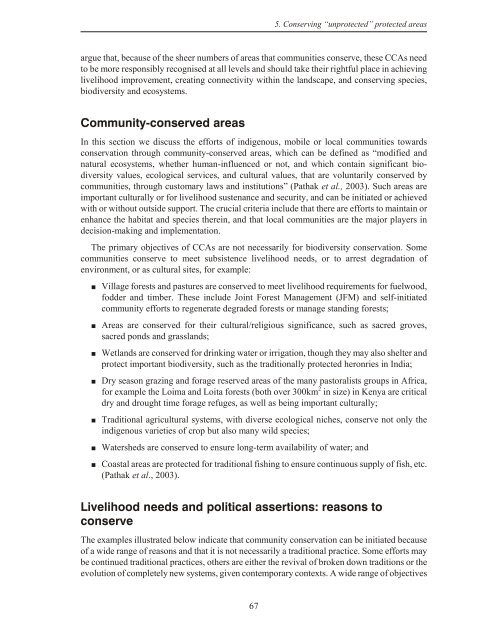The Protected Landscape Approach - Centre for Mediterranean ...
The Protected Landscape Approach - Centre for Mediterranean ...
The Protected Landscape Approach - Centre for Mediterranean ...
Create successful ePaper yourself
Turn your PDF publications into a flip-book with our unique Google optimized e-Paper software.
5. Conserving “unprotected” protected areas<br />
argue that, because of the sheer numbers of areas that communities conserve, these CCAs need<br />
to be more responsibly recognised at all levels and should take their rightful place in achieving<br />
livelihood improvement, creating connectivity within the landscape, and conserving species,<br />
biodiversity and ecosystems.<br />
Community-conserved areas<br />
In this section we discuss the ef<strong>for</strong>ts of indigenous, mobile or local communities towards<br />
conservation through community-conserved areas, which can be defined as “modified and<br />
natural ecosystems, whether human-influenced or not, and which contain significant bio -<br />
diversity values, ecological services, and cultural values, that are voluntarily conserved by<br />
communities, through customary laws and institutions” (Pathak et al., 2003). Such areas are<br />
important culturally or <strong>for</strong> livelihood sustenance and security, and can be initiated or achieved<br />
with or without outside support. <strong>The</strong> crucial criteria include that there are ef<strong>for</strong>ts to maintain or<br />
enhance the habitat and species therein, and that local communities are the major players in<br />
decision-making and implementation.<br />
<strong>The</strong> primary objectives of CCAs are not necessarily <strong>for</strong> biodiversity conservation. Some<br />
communities conserve to meet subsistence livelihood needs, or to arrest degradation of<br />
environment, or as cultural sites, <strong>for</strong> example:<br />
<br />
<br />
<br />
<br />
<br />
<br />
<br />
Village <strong>for</strong>ests and pastures are conserved to meet livelihood requirements <strong>for</strong> fuelwood,<br />
fodder and timber. <strong>The</strong>se include Joint Forest Management (JFM) and self-initiated<br />
community ef<strong>for</strong>ts to regenerate degraded <strong>for</strong>ests or manage standing <strong>for</strong>ests;<br />
Areas are conserved <strong>for</strong> their cultural/religious significance, such as sacred groves,<br />
sacred ponds and grasslands;<br />
Wetlands are conserved <strong>for</strong> drinking water or irrigation, though they may also shelter and<br />
protect important biodiversity, such as the traditionally protected heronries in India;<br />
Dry season grazing and <strong>for</strong>age reserved areas of the many pastoralists groups in Africa,<br />
<strong>for</strong> example the Loima and Loita <strong>for</strong>ests (both over 300km 2 in size) in Kenya are critical<br />
dry and drought time <strong>for</strong>age refuges, as well as being important culturally;<br />
Traditional agricultural systems, with diverse ecological niches, conserve not only the<br />
indigenous varieties of crop but also many wild species;<br />
Watersheds are conserved to ensure long-term availability of water; and<br />
Coastal areas are protected <strong>for</strong> traditional fishing to ensure continuous supply of fish, etc.<br />
(Pathak et al., 2003).<br />
Livelihood needs and political assertions: reasons to<br />
conserve<br />
<strong>The</strong> examples illustrated below indicate that community conservation can be initiated because<br />
of a wide range of reasons and that it is not necessarily a traditional practice. Some ef<strong>for</strong>ts may<br />
be continued traditional practices, others are either the revival of broken down traditions or the<br />
evolution of completely new systems, given contemporary contexts. A wide range of objectives<br />
67

















